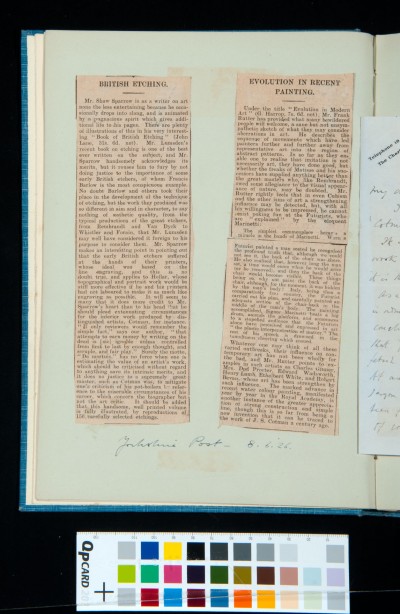Cotmania. Vol. I. 1926-7
Archive: SDK Sydney Decimus Kitson Archive
Reference Number: SDK/1/2/1/1
Page: 4 verso
-
Description
British Etching / Evolution in Recent Painitng.
Two Yorkshire Post press cuttings.
Date: 08-Jun-26
-
Transcription
BRITISH ETCHING
Mr Shaw Sparrow is a writer on art none the less entertaining because he occasionally drops into slang, and is animated by a pugnacious spirit which gives additional life to his pages. There are plenty of illustrations of this in his very interesting "Book of British Etching" John Lane, 31s 6d. net. Mr. Lumsden's recent book on etching is one of the best ever written on the subject, and Mr. Sparrow handsomely acknowledges its merits, but it rouses him to fury by not doing justice to the importance of some early British etchers, of whom Francis Barlow is the most conspicuous example. No doubt Barlow and others took their place in the development of the technique of etching, but the work they produced was so different in aim and in character, to say nothing of aesthetic quality, from the typical productions of the great etchers, from Rembrandt and Van Dyck to Whistler and Forain, that Mr Lumsden may well have considered it foreign to his purpose to consider them. Mr Sparrow makes an interesting point in pointing out that the early British etchers suffered at the hands of their printers, whose ideal was based on the line engraving, and this is no doubt true, and applies to Hollar, whose topographical and portrait work would be still more effective if he and his printers had not laboured to make it as much like engraving as possible. It will seem to many that it does more credit to Mr. sparrow's heart than to his head that he should plead extenuating circumstances for the inferior work produced by distinguished artists, Cotman, for instance. "If only reviewers would remember the simple fact," says our author, "that attempts to earn money by writing on the dead is[sic] ignoble unless controlled from first to last by enough thought, and scruple, and fair play." Surely the motto, De Mortuis," has no force when one is estimating the value of an artists work, which should be criticised without regard to anything save its intrinsic merits, and it does no justice to a supremely great master, such as Cotman was, to mitigate one's criticism of his pot-boilers by reference to the miserable circumstances of his career, which concern the biographer, but not the art critic. It should be added that this handsome volume is fully illustrated, by reproductions of 156 carefully selected etchings. {Yorkshire Post - 8.6.26}/
EVOLUTION IN RECENT PAINTING
Under the title "Evolution in Modern Art" (G.Harrop, 7s 6d net), Mr. Frank Rutter has provided what many bewildered people will welcome, a sane but not unsympathetic sketch of what they may consider aberrations in art. He describes the sequence of movements which have led painters further and further away from representative art into the region of abstract patterns. In so far as they enable one to realise that imitation is not necessarily art, they have done good, but whether the freaks of Matisse and his sucessors have supplied anything better than the great masters who like Rembrandt, owed some allegiance to the visual appearance of nature, may be doubted. Mr Rutter rightly feels that in even Cubism and the other isms of art a strengthening influence may be detected but, with all his willingness to be impressed, he cannot resist poking fun at the Futurists, who are "explained" by the eloquent Marinetti: The simplest commonplace become a miracle in the hands of Marinetti. When a Futurist painted a man seated he recognised the profound truth that, although we could not see it, the back of the chair was there. He also realised that, however long the man sat, a time would come when he would arise (or be removed), and then the back of the chair would become visible. These things being so why not pain the back of the chair although, for the moment, it was hidden by the man's body? Italy being then a comparatively free country, the Futurists carried out his plan, and carefully painted an adequate section of the chair-back in the middle of the man's body. The painting accomplished, Signor Marinetti beats a big drum, ascends the platform, and announces to a stupefied audience that the Futurists alone have perceived and expressed in art " the plastic interpenetration of matter." The rest of his speech is drowned in the tumultous cheering which ensued. Whatever one may think of all these varied outbreaks, their influence on contemporary art has not been wholly for the bad, and Mr. Rutter points to examples in such artists as Charles Ginner, Mrs. Dod Procter, Edward Wadsworth, Henry Lamb, Ethelbert White, and Robert Bevan, whose art has been strengthened by such influence. The marked advance in recent water colour painting, manifested year by year in the Royal Academy, is another instance of the greater appreciation of strong construction and simple line, though this is so far from being a new invention that it can be traced to the work of J.S.Cotman a century ago. {Yorkshire Post - 8.6.26}
